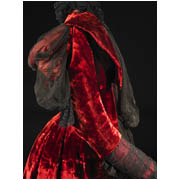Details
- Object type
dress; house dress; tea gown
- Artist/Maker
- Place Associated
Scotland, Glasgow, 37 Buchanan Street (place of manufacture)
- Date
circa 1891-1893
- Materials
silk, cotton, metal
- Dimensions
bust: 860 mm; footprint: 650 mm x 950 mm; waist: 610 mm
- Description
-
Woman’s dress, house dress or tea gown in red silk cut pile velvet plush with black cotton net and black machine-made lace. Small round collar trimmed with two rows of black lace, princessline cut body constructed with panels from collar to hem, centre front panel of black net over red silk fastening down right side with black metal hooks and eyes, half-belt of black net fastening front right waist, side and back panels in red velvet. Full-length sleeves in red velvet with upper arm slashed along top with inset of puffed black net over red silk decorated with black lace at bottom. Wrist with ruched black net over velvet with black lace at cuff. Skirt, full-length with slight train at back with two inverted box pleats at centre back waist to increase material in skirt and form a slight bustle. Lined with red cotton fastening centre front with seventeen (four missing) cream buttons, cream twill tape waist tape stamped in green 'D. Kemp & Son / Glasgow'. Cream pleated cotton and machine-made lace frill around hem. Bodice originally fitted at front with darts, but two subsequently unstitched.
Tea gowns were relaxed garments that crossed the divide between main garments and dressing wear. Often, wealthy ladies would change several times a day. A loose-fitting gown would be suitable to wear in the afternoon at home, in the period after tea, but before dinner, hence the name ‘tea gown’. Since the tea gown is relaxed in cut and fit, women could wear them without their corsets underneath or done-up, as a comfortable and luxurious item to wear while relaxing in the privacy of your own home.
C W Cunnington noted in English Women’s Clothing in the Nineteenth Century, 1937, that the 'House Dress (developed from the teagown) is trained; brighter in colour and richer in material than the ordinary day dress; and closer fitting than the teagown; teagowns can be worn without stays but not the house dress.’ This crimson red plush velvet is certainly a bright, rich material, but without knowing the original wearer's dimensions it is not possible to ascertain how close-fitting this bodice was.
- Credit Line/Donor
Museum Purchase, 1985
- ID Number
E.1985.90
- Location
In storage






